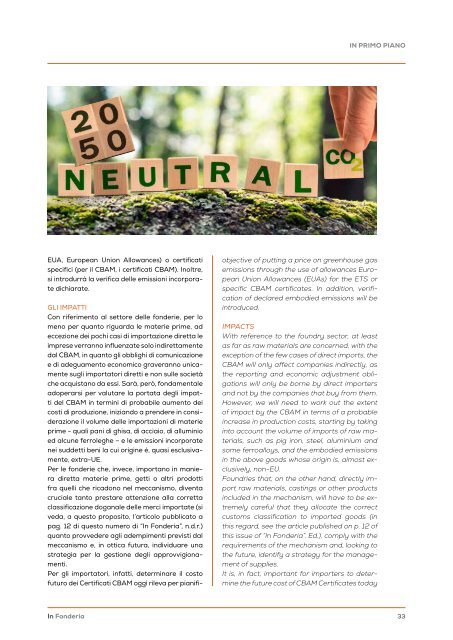In Fonderia 1 2024
Primo numero del 2024 di In Fonderia
Primo numero del 2024 di In Fonderia
You also want an ePaper? Increase the reach of your titles
YUMPU automatically turns print PDFs into web optimized ePapers that Google loves.
IN PRIMO PIANO<br />
EUA, European Union Allowances) o certificati<br />
specifici (per il CBAM, i certificati CBAM). <strong>In</strong>oltre,<br />
si introdurrà la verifica delle emissioni incorporate<br />
dichiarate.<br />
GLI IMPATTI<br />
Con riferimento al settore delle fonderie, per lo<br />
meno per quanto riguarda le materie prime, ad<br />
eccezione dei pochi casi di importazione diretta le<br />
imprese verranno influenzate solo indirettamente<br />
dal CBAM, in quanto gli obblighi di comunicazione<br />
e di adeguamento economico graveranno unicamente<br />
sugli importatori diretti e non sulle società<br />
che acquistano da essi. Sarà, però, fondamentale<br />
adoperarsi per valutare la portata degli impatti<br />
del CBAM in termini di probabile aumento dei<br />
costi di produzione, iniziando a prendere in considerazione<br />
il volume delle importazioni di materie<br />
prime - quali pani di ghisa, di acciaio, di alluminio<br />
ed alcune ferroleghe – e le emissioni incorporate<br />
nei suddetti beni la cui origine è, quasi esclusivamente,<br />
extra-UE.<br />
Per le fonderie che, invece, importano in maniera<br />
diretta materie prime, getti o altri prodotti<br />
fra quelli che ricadono nel meccanismo, diventa<br />
cruciale tanto prestare attenzione alla corretta<br />
classificazione doganale delle merci importate (si<br />
veda, a questo proposito, l’articolo pubblicato a<br />
pag. 12 di questo numero di “<strong>In</strong> <strong>Fonderia</strong>”, n.d.r.)<br />
quanto provvedere agli adempimenti previsti dal<br />
meccanismo e, in ottica futura, individuare una<br />
strategia per la gestione degli approvvigionamenti.<br />
Per gli importatori, infatti, determinare il costo<br />
futuro dei Certificati CBAM oggi rileva per pianifiobjective<br />
of putting a price on greenhouse gas<br />
emissions through the use of allowances European<br />
Union Allowances (EUAs) for the ETS or<br />
specific CBAM certificates. <strong>In</strong> addition, verification<br />
of declared embodied emissions will be<br />
introduced.<br />
IMPACTS<br />
With reference to the foundry sector, at least<br />
as far as raw materials are concerned, with the<br />
exception of the few cases of direct imports, the<br />
CBAM will only affect companies indirectly, as<br />
the reporting and economic adjustment obligations<br />
will only be borne by direct importers<br />
and not by the companies that buy from them.<br />
However, we will need to work out the extent<br />
of impact by the CBAM in terms of a probable<br />
increase in production costs, starting by taking<br />
into account the volume of imports of raw materials,<br />
such as pig iron, steel, aluminium and<br />
some ferroalloys, and the embodied emissions<br />
in the above goods whose origin is, almost exclusively,<br />
non-EU.<br />
Foundries that, on the other hand, directly import<br />
raw materials, castings or other products<br />
included in the mechanism, will have to be extremely<br />
careful that they allocate the correct<br />
customs classification to imported goods (in<br />
this regard, see the article published on p. 12 of<br />
this issue of “<strong>In</strong> <strong>Fonderia</strong>”. Ed.), comply with the<br />
requirements of the mechanism and, looking to<br />
the future, identify a strategy for the management<br />
of supplies.<br />
It is, in fact, important for importers to determine<br />
the future cost of CBAM Certificates today<br />
<strong>In</strong> <strong>Fonderia</strong><br />
33














